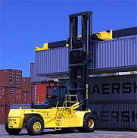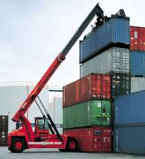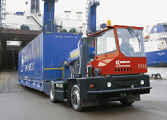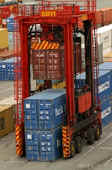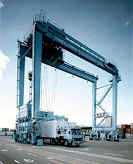HIPAVE
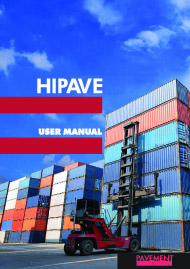
HIPAVE (Heavy Industrial PAVEment design) is software for the design of flexible pavements in facilities such as intermodal container terminals and yards.
HIPAVE models the extremely heavy loads from vehicles such as mast lifts, reach stackers, straddle carriers etc.
HIPAVE is an outgrowth of CIRCLY and APSDS (Airport Pavement Structural Design System). CIRCLY was first released in 1977 and APSDS in 1995.
HIPAVE has unique features to streamline pavement design projects:
- ability to define and store container weight distributions
- automatic calculation of axle loads from vehicle geometry and container weight.
HIPAVE handles the variety of mobile equipment used in container facilities, such as forklifts, mast lifts, reach-stackers, straddle carriers, gantry cranes and side loaders.
|
|
|
|
||
|
|
|
HIPAVE takes account of vehicle wander at a more fundamental level than earlier methods. Wander is the measure of how successive vehicle movements deviate from lane centre lines.
Increased wander reduces pavement damage by different amounts that depend on pavement thickness.
Incorporating wander can lead to significant savings in construction costs.
A Parametric Analysis feature can loop through a range of thicknesses for one or two layers while simultaneously designing the thickness of another layer. This feature will optimise up to three layers. The Cost Analysis feature lets you fine-tune layer thicknesses to lower construction and maintenance costs.
HIPAVE has many other powerful features, including choice of:
- cross-anisotropic and isotropic material properties
- fully continuous (rough) or fully frictionless (smooth) layer interfaces
- a comprehensive range of load types, including vertical, horizontal, torsional, etc.
- non-uniform surface contact stress distributions; and
- automatic sub-layering of unbound granular materials.
Click here for recorded Demonstrations.
Download the Product Brochure: HIPAVE 5.0 Advanced design of heavy duty industrial pavements – Brochure
Download the Product Overview Slideshow: HIPAVE Overview
Click here to view two conference papers on HIPAVE – how it works and two Case Studies.
Click here for more details on HIPAVE.
Heavy Duty Industrial Pavement Design Guide
We developed the Heavy Duty Industrial Pavement Design Guide to help users of the HIPAVE software. The Guide is a collaborative effort currently involving Leigh Wardle of Mincad Systems, Ian Rickards (Pioneer Road Services Pty Ltd, Melbourne, Australia), John Lancaster (VicRoads, Australia) and Dr Susan Tighe (Dept. Civil Engineering, University of Waterloo, Canada).
Download the Guide: Heavy Duty Industrial Pavement Design Guide.
Unique design system for Airport Pavements
A unique design system, APSDS (Airport Pavement Structural Design System) is used for airport pavements. It is based on the CIRCLY system and has been modified to suit the design of airport pavements.
Click here for a comparison of the features of our three pavement design packages.
Make sure you use appropriate Performance Data
Here is an article that explains why road design methods are not appropriate for the heavy loadings encountered at airports and container terminals. Road design methods can give grossly under-designed pavements. For further details see Layered Elastic Design Of Heavy Duty And Industrial Pavements – Rodway, B. and Wardle, L.J. (1998).
HIPAVE Referenced in PIANC Guide – Design and Maintenance of Container Terminal Pavements
See this 163 page report: MarCom WG 165 – Design and Maintenance of Container Terminal Pavements (2015).
This report covers these design methods: HIPAVE, British Port Association (BPA) Edition 4 (2007), French LCPC Method (using ALIZE software) and the Sector Standard of the People’s Republic of China – Code for Design and Construction of Pavements Roads and Stockyards in Ports – JTJ 296-96, 1997.
PIANC has Technical Commissions concerned with inland waterways and ports (InCom), coastal and ocean waterways (including ports and harbours) (MarCom), environmental aspects (EnviCom) and sport and pleasure navigation (RecCom).
This report has been produced by an international Working Group convened by the Maritime Navigation Commission (MarCom). Members of the Working Group represent several countries and are acknowledged experts in their profession.
The objective of this report is to provide information and recommendations on good practice. Conformity is not obligatory and engineering judgement should be used in its application, especially in special circumstances. This report should be seen as an expert guidance and state of the art on this particular subject. PIANC is not a certifying body and disclaims all responsibility in case this report should be presented as an official standard and/or as a certification.





